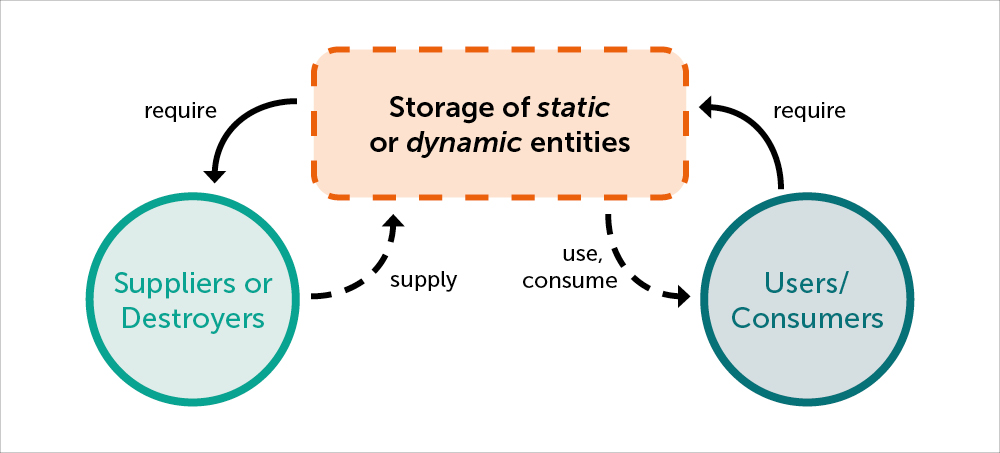Authors: Janos Korn
Janos Korn, retired from Department of Design Engineering and Mathematics, Middlesex University, London, considers the role of digital technology in contributing to a more sustainable future by examining the intricate interplay between users, suppliers and storage.
Digital technology or the vast array of electronic devices for handling information, is a recently available aid for the management of human activities. It serves as a means for storing and transmitting data, establishing rules for controlling machines and people, and facilitating entertainment and direct communication through online games and mobile telephones. The current high consumption of materials, energy and transmission of information raises questions about the sustainability of these activities, especially given the inevitable waste and exploitation of resources facilitated by digital technology.
There is a widespread view that:
- Use of digital technology can contribute to prolonging the sustainability of exploiting limited resources and reducing waste.
- Measures, such as the introduction of electric cars, can modify human consumption patterns.
Points 1 and 2 imply that the generation of ideas as part of problem solving, design and organisation of activities appear to be conducted at a speculative, verbal level. The aim of this editorial is to show how the concept of sustainability can be more precisely expressed, demonstrating the role of digital technology and integrating it into a broader perspective of living activities [Schwab, 2016, Korn, 2023, 2024].
A view of sustainability
Our initial experiences with the world involve receiving impressions through our sense organs, followed by recognition in the brain/mind and assignment of a symbolic structure or designation. Recognition of the impression can be followed by a comment like ‘it looks like friend or enemy’, ‘taste nice or foul’ and so on.
In other words, an impression has empirical content which may be said to be stored in the entity generating the impression.
Accordingly, we have identified the first symbolic object generated by the empirical world = Storage. Examples of what can be stored include:
- Properties – Warm [in a room], Colour [of the shirt], Variety [of cars]
- Energy – Electrical [in a battery], Mechanical [in a coil spring], Potential [water in a dam], Information – Books [in a library], News [on tv], Announcement [of arrival of train]
- Matter --- Coal, oil, water, gold [in the earth], Food [in a supermarket]
- Expertise – Healing [in a surgery], Repair [in a garage]
- Experience – Practical knowhow of cultivating the land [in the mind]
The number and variety of symbolic objects in the perceivable world is very large so the list is very long.
Remark 1. The level of storage is not constant. The content of storage can erode, destroyed, become worn, be left by personnel or used or consumed. A state of equilibrium does not remain constant. To keep the level of the content constant, storage of any kind needs to be sustained or supplied. [End of remark]. Accordingly, we have identified the second and third symbolic object of the empirical world which can interfere with storage by chance or purpose = User/consumer and Supplier.
Remark 2. Users/consumers and Suppliers can use, consume or supply or sustain only if aspects of content of Storage match what is used, consumed or supplied. In other words, the three entities are related by requirements which is shown in Figure 1. [End of remark].

Figure 1. Diagram of sustainability
The diagram in Figure 1. can be read approximately as follows = ‘There is a consumer who regularly consumes a quantity of goods provided [the goods are available when needed, in sufficient quantity and quality and within easy reach]. These requirements are satisfied by the content in the local storage depot. The depot informs the supplier about them [the details of the required goods] which it can deliver promptly.’
For example: ‘There is a family of four who are very keen on eating carrots which they prefer [to be of regular shape, at least 10cm long and packed in 1kg plastic bags]. The local supermarket usually stocks carrots which satisfy this set of requirements. The supermarket informs the nearby farmers [about the required properties of the carrots] and expects prompt delivery’.
In the story the square brackets enclose the requirements.
Remark 3. Using Figure 1. the term ‘sustainability’ refers to the ‘existence of a state of equilibrium through maintenance of content of the store, between the activities of supplier/destroyer and user/consumer/rebuilder’. This means that the activities must carry entities which match those in the store. For example, the owner of car make X must go for servicing to the garage with expertise of cars make X. Also, the Earth as a store of resources, cannot be in equilibrium because it cannot be supplied. [End of remark]
Application of digital technology
The term ‘digital technology’ describes electronic devices that generate, store, process data and can manipulate rules based on the operation of ‘expert systems’ which simulate the behaviour of a human with expertise in a particular field. An expert system or artificial intelligence (AI) can make decisions and control machines and humans. Digital technology is the product of human ingenuity, it is an invention. However, other inventions replace human muscle to create amplification, increase convenience or performance but still need decision-making and control – digital technology covers the whole. For this reason, AI appears a threat to humanity.
All inventions have been created to:
A. Assist survival of humans but no other living things [as far known unless natural selection is seen as such]
B. Improve efficiency of performance
C. Increase convenience to which we add
D. Facilitate sustenance of content of storage and operation of users/consumers and suppliers
Application of digital technology is directed at evaluation of how it contributes to points A, B, C, D. For example, ‘In a doctor’s surgery the patient goes to the receptionist ‘to register and to notify’ the doctor of their presence. The receptionist’s activity has been replaced by a small, digital panel to be touched by the patent’.
Has this replacement contributed to the sustainability of surgery as a ‘storage of expertise’?
Answer = ‘Storage of expertise’ of Healing in a surgery is maintained by ‘doctors’ for whom awareness of the presence of patients is a necessary condition. It is communicated by a ‘digital panel’ just as well as by the receptionist, otherwise it would be unsuitable. However, the receptionist needs to be paid, occupies much more space with air, heat in winter and other facilities which erode the sustainability of surgery. So from this narrow point of view the ‘digital panel’ has the advantage in contributing to sustainability.
Conclusions
A view of sustainability is described which points towards more precision and development of a coherent whole of sustainability and digital technology. The view can fit into a general model of living activity [Korn, 2023].
The role of digital technology in sustainability is demonstrated by a simple example which is based on evaluating aspects of the differences between existing methods for catering for points A, B, C, D and those assisted by digital technology. This suggestion needs to be developed further before it can be seen as an analytical tool and can be applied to small and large projects involving resources stored by the Earth.
Invention, emotion and technology have been the driving force of society through furthering points A, B, C, D by creating Industrial Revolutions.
Currently, digital technology is regarded as the essential part of the 4th Industrial Revolution in furthering sustainability of natural resources and reducing waste.
Clarification of the relation between digital technology and sustainability described here subject to peer review, can help in this worldwide effort [Schwab, 2016, Korn, 2024].
References
Korn J., Existence as a web of problem solving, Kybernete
Korn J., Co-evolution of technology and society, I J of Markets and Business Systems, to be published, 2024.
Schwab K., The fourth industrial revolution, World Economic Forum, 2016.

Sustainable structures and infrastructures
We are passionate about supporting researchers, policymakers, and practitioners in their efforts to minimise the environmental impact of structures and infrastructures.
